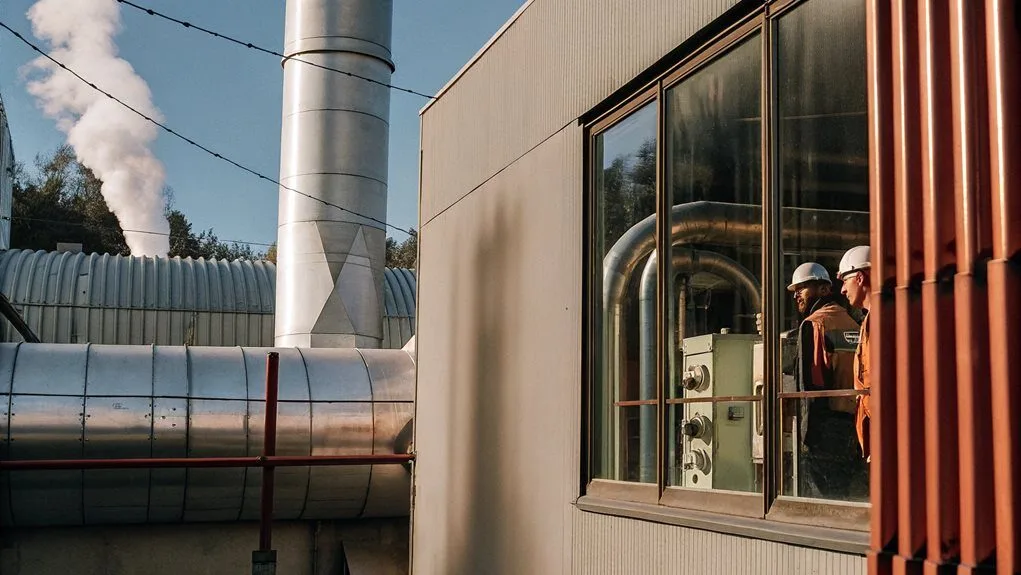Combined Heat & Power: High-Efficiency Energy for UK Businesses
Combined Heat and Power (CHP) generates electricity on-site and captures the waste heat for productive uses such as process hot water, space heating, or absorption chilling. Modern cogeneration plants deliver 65 – 90 % system efficiency versus 45 – 55 % for separate heat-and-power systems, helping manufacturers, data centres, leisure venues, and healthcare estates cut fuel spend and carbon emissions.
How Commercial CHP Works
A prime mover—gas turbine, reciprocating engine, micro-turbine, or fuel cell—spins a generator. Instead of venting exhaust, a heat-recovery unit channels it through a plate heat-exchanger, delivering low-cost thermal energy on-site. Locating the plant inside the facility avoids transmission losses, boosts resilience during grid outages, and supports Ampergia’s smart-microgrid strategies.
Waste-Heat Recovery & Simultaneous Generation
Traditional power stations discard nearly two-thirds of input energy as heat. CHP recovers this “free” resource, enabling Bloom Energy Servers operating above 800 °C to reach almost 90 % efficiency. Fuel flexibility—natural gas, propane, biogas, or hydrogen blends—adds supply security and supports long-term decarbonisation goals.
- Operating savings 20 – 40 % – on-site electricity at 6–8 p/kWh displaces grid power at ~18 p/kWh, while recovered heat offsets boiler gas.
- Carbon reduction ≤ 30 % – fewer kWh burned per unit of useful energy; deeper cuts when fuelled with biogas or hydrogen-ready blends.
- Energy resilience – delivers critical-load power during outages; ideal for hospitals, cold-storage depots, and manufacturing lines.
- Revenue streams – surplus export, Renewable Obligation Certificates, and Enhanced Capital Allowances shorten payback to < 5 years.
Real-World Business Results
Logistics depot, Midlands — a 1 MWe CHP cut annual gas and power bills by £480 k and trimmed CO₂ by 1 100 t after a £350 k Green Heat Network Fund grant.
Brewery taproom, North-West — four 60 kWe units integrated with heat-recovery ventilators halved winter heating costs while keeping fermentation at precise temperatures.
Care-home group, South-East — ground-source CHP upgraded EPC ratings from D to B, unlocking a green-loan interest rate 45 bp below standard lending. Detailed numbers are documented in the HELEC case library.
Key Components & Future Trends
Prime movers, generators, heat-recovery exchangers, and hybrid absorption chillers form the core of a CHP plant. Fuel quality monitoring, microgrid controls, and retro-fit-ready interconnection gear ensure seamless integration with existing switchgear and boilers. The next wave of innovation pairs CHP with hydrogen-ready generators and thermal-battery storage to achieve net-zero-ready, dispatchable heat.
- Hybrid CHP + Solar/BESS – maximises self-consumption and shields sites from Triad and DUoS peaks.
- District-energy networks – campus-scale plants supply multiple buildings with low-carbon heat via insulated loops.
- Hydrogen & RNG blends – trials show 20 % H₂ mix without hardware changes; biogas CHP already cuts GHG up to 90 %.
Plan Your CHP Project
Talk with Ampergia’s engineers to size a CHP plant for your facility and start capturing waste heat for immediate savings.

